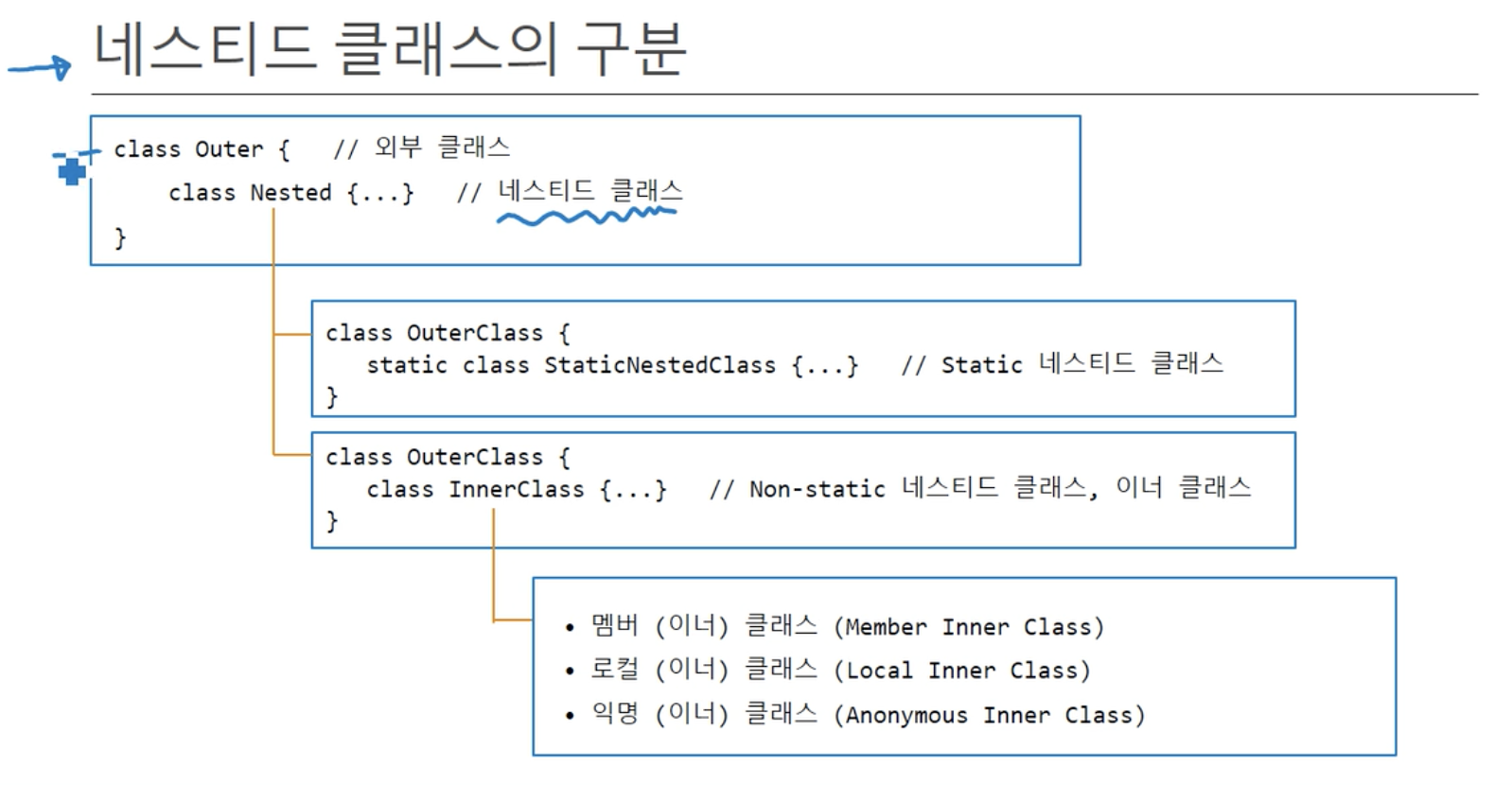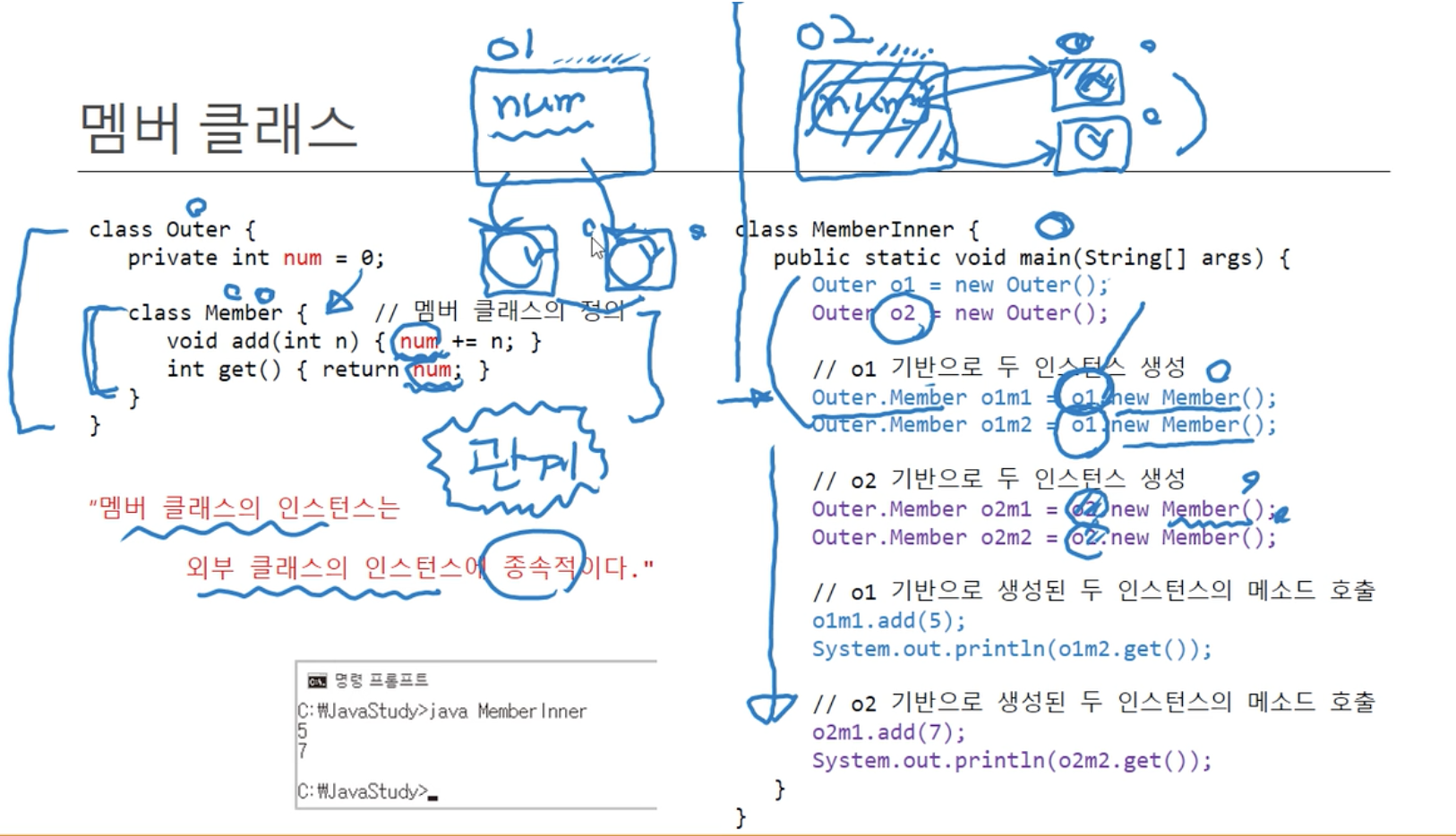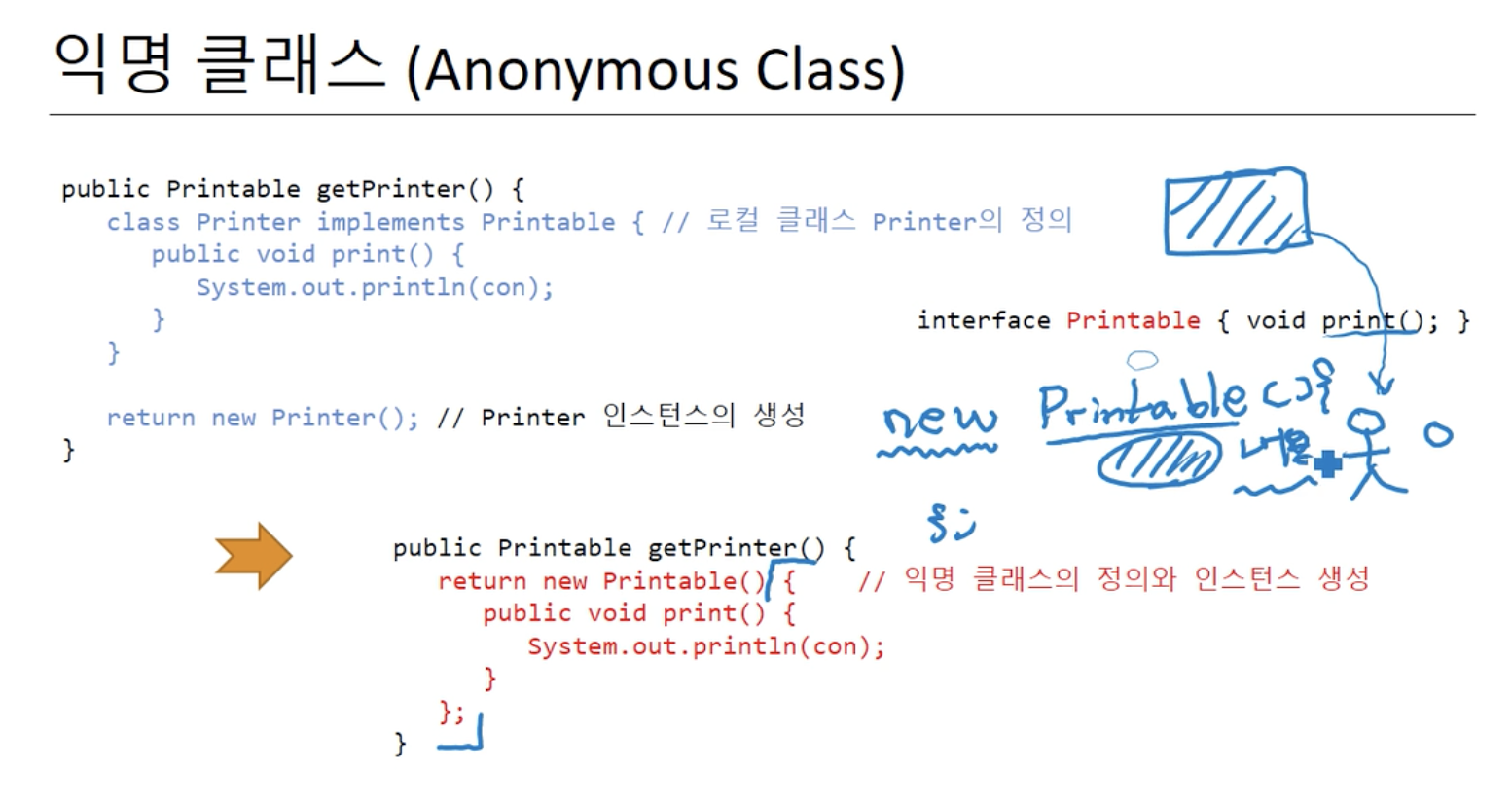
Section 01
Goal
네스티드 클래스와 람다의 소개에 대해 간략히 정리 해보자.
네스티드 클래스와 이너 클래스
알 필요가 있는 부분이지만 강제로 기억 할 필요가 없는 부분이다.
네스티드 클래스

class Outer { // 외부 클래스
class Nested {...} // 네스티드 클래스
}
class OuterClass {
static class StaticNestedClass {...} // Static 네스티드 클래스
}
class OuterClass {
class InnerCLass {...} // Non-Static 네스티드 클래스, 이너 클래스
}- 클래스 안에 정의된 클래스를 네스티드 클래스라 말한다.
- 또한 네스티드 클래스를 감싸고 있는 클래스를 외부 클래스라 한다.
네스티드 클래스는 두 가지로 분류가 된다.
- static이 붙은 네스티드 클래스. → Static 네스티드 클래스
- staitc이 붙지 않은 네스티드 클래스. → 이너 클래스 또는 내부 클래스
또한 이너 클래스는 세 가지로 분류가 된다.
- 맴버 (이너) 클래스 (Member Inner Class)
- 로컬 (이너) 클래스 (Local Inner Class)
- 익명 (이너) 클래스 (Anonymous Inner Class)
Static Nested Class
Class Outer {
private static int num = 0;
static class Nested1 { // **Static 네스티드 클래스**
void add(int n) {
num+=n; // **Outer 클래스의 static 변수 공유!**
}
}
static class Nested2 { // **Static 네스티드 클래스**
int get() {
return num; // **Outer 클래스의 static 변수 공유!**
}
}
} // Outer
class StaticNested {
public static void main(String[] args) {
Outer.Nested1 nst1 = new Outer.Nested1(); // 인스턴스 생성 방법!
nst1.add(5);
Outer.Nested2 nst2 = new Outer.Nested2();
System.out.println(nst2.get());
}
}- 클래스 안에서 static이 붙으면 자리를 빌려 들어 왔다 생각하고 해당 클래스와 아무 관계가 없다.
- 위 코드에서 Outer 클래스와 네스티드 클래스는 별개로 바라봐야 한다.
- 인스턴스 생성 방법에 있어 기존 클래스의 객체를 생성하는 것 과는 차이가 있다.
출력
5내부 클래스
우선 들어가기에 앞서 내부 클래스(이너 클래스-Inner Class)는 Static Nested 클래스와는 다른 클래스로 바라봐야 한다.
내부 클래스의 구분
맴버 클래스 (Member Class)
- 인스턴스 변수, 인스턴스 메소드와 동일한 위치에 정의.
- 인스턴스 생성 시 존재 하는 변수를 인스턴스 변수라 지칭 한다.
- 인스턴스 생성 시 존재 하는 메소드를 인스턴스 메소드라 지칭 한다.
- 즉, 맴버 클래스는 인스턴스 생성 시 인스턴스 변수, 메소드와 대등한 위치에 존재하는 클래스를 의미 한다.
로컬 클래스 (Local Class)
- 중괄호 내에, 특히 메소드 내에 정의.
- 특정 메소드 내로 해당 클래스를 완전히 숨김으로써, 보이는 범위(접근 할 수 있는 범위)를 메소드 내로 제한 한 것이다.
익명 클래스 (Anonymous Class)
- 클래스인데 이름이 없어! 😂
내부 클래스 예제 01
class Outer {
class MemberInner {
... // 맴버 클래스
}
void method() {
class LocalInner {
... // 로컬 클래스
}
}
}맴버 클래스

class Outer {
private int num = 0;
class Member { // 내부 클래스 혹은 이너 클래스 -> Class 내에 선언된 클래스
void add(int n) { num+=n;}
int get() {return num;}
}
// 맴버 클래스의 인스턴스는 외부 클래스의 인스턴스에 종속적이다.
}
class MemberInner {
public static void main(String[]args) {
Outer o1 = new Outer();
Outer o2 = new Outer();
// o1 기반으로 두 인스턴스 생성
Outer.Member o1m1 = o1.new Member();
Outer.Member o1m2 = o1.new Member();
// o2 기반으로 두 인스턴스 생성
Outer.Member o2m1 = o2.new Member();
Outer.Member o2m2 = o2.new Member();
// o1 기반으로 생성된 두 인스턴스의 메소드 호출
o1m1.add(5);
System.out.println(o1m2.get());
// o2 기반으로 생성된 두 인스턴스의 메소드 호출
o2m1.add(5);
System.out.println(o2m2.get());
}
}- 첫번째로 외부 클래스와 Member 클래스는 깊은 관계를 가지고 있다?
- 또한 외부 클래스를 기반으로 내부 클래스를 사용 하기에, 외부 클래스에 데이터에 접근이 용이하다.
- Member 클래스의 인스턴스는 외부 클래스의 인스턴스에 종속적이다.
- 즉, Member 클래스(내부 클래스)는 독립적으로 존재가 불가능하다.
- Member member = new Member(); ← 이런 문장은 선언이 불가능하다.
- Outer.Member o1m1 = o1.new Member();
- Outer.Member o1m1 = o2.new Member();
출력
5
7맴버 클래스를 언제 사용 하는가?
interface Printable {
void print();
}
class Papers {
private String con;
public Papers(String s) {
con = s;
}
public Printable getPrinter() { // Printer를 반환형으로 넘겨줘도 상관 없다.
return new Printer();
}
// Paper Class 안에 Printer 클래스를 감춘 상태.
private class Printer implements Printable {
public void print() {
System.out.println(con);
}
}
}
public static void main(String[] args) {
Papers p = new Papers("서류 내용 : 행복합니다.");
Printable prn = p.getPrinter();
prn.print();
}- 맴버 클래스는 클래스의 정의를 감추어야 할 때 유용하게 사용이 된다.
- 클래스 사용자 입장에서 Printable 인터페이스는 알지만 Printer 클래스는 모른다!
- 즉, Printer 클래스를 아무리 뜯어 고친다 한들 상관이 없다.
로컬 클래스 (Local Class)
interface Printable {
void print();
}
class Papers {
private String con;
public Papers(String s) {
con = s;
}
public Printable getPrinter() {
class Printer implements Printable {
public void print() {
System.out.println(con);
}
}
// 감췄어! 더 깊이 감췄어!! 메소드 안으로**
return new Printer();
}
}
public static void main(String[] args) {
Papers p = new Papers("서류 내용 : 행복합니다.");
Printable prn = p.getPrinter();
prn.print();
}- 로컬 클래스는 해당 내부 클래스를 더 깊이 감추기 위해 사용이 되는 형태이다.
- 익명 클래스는 위 같은 상황에서 클래스 이름이 필요하지 않을 때 사용이 되는 형태이다.
출력
서류 내용 : 행복합니다.익명 클래스 (Anonymous Class)
public Printable getPrinter() {
class Printer implements Printable { // 로컬 클래스의 Printer의 정의
public void print() {
System.out.println(con);
}
}
return new Printer(); // Printer 인스턴스 생성
}
------------------------> 변경 후
public Printable getPrinter() {
return new Printable() { // 익명 클래스의 정의와 인스턴스 생성
public void print() {
System.out.println(con);
}
};
}- Printable Interface를 구현한 인스턴스를 생성 해라.
- 근데 인터페이스에 존재하는 void print() 메소드는 추상 메소드로 비어 있는데요??
- 그러면 익명 클래스를 사용하여 구현을 해봐 👍
Javascript에서 사용한 ES6 문법 화살표 함수와 유사, 람다식과 유사하다
익명 클래스 (Anonymous Class) 02

-
Printable Interface를 구현한 클래스의 인스턴스를 너가 컴파일 해줘~~~!
-
public void print()의 출처가 어디인지 알려주는 것 → return new Printable();
-
new Printable() : Printable Interface를 구현한 클래스의 인스턴스를 생성 해라.
-
그런데 위 인스턴스 안에는 아래 메소드의 정의를 담아라.
public void print() { System.out.println(con); }
-
🌟 람다 (Lambda)
람다의 기본 골격은 익명 클래스를 기반으로 만들어진다 봐도 무방하다, 지금부터 람다에 대해 정리 해보자.
익명 클래스 예제 01
interface Printable {
void print(String s);
}
class Lamda01 {
public static void main(String[] args) {
Printable prn = new Printable() { // 익명 클래스
public void print(Stirng s) {
System.out.println(s);
}
};
prn.print("What is Lamda?");
}
}람다 예제 01
interface Printable {
void print(String s);
}
class Lamda01 {
public static void main(String[] args) {
Printable prn = new Printable() { // 익명 클래스
public void print(Stirng s) {
System.out.println(s);
}
};
prn.print("What is Lamda?");
}
}
-------------------------> 변경 후
interface Printable {
void print(String s);
}
class Lamda01 {
public static void main(String[] args) {
Printable prn = (s) -> { System.out.println(s); } // Lamda -> 화살표 함수 똑같음.
prn.print("What is Lambda?");
}
}- Printable prn = (s) → { System.out.println(s); }
- (s) : 컴파일러는 (s)를 → 매개변수 s가 들어오는 것으로 판단을 한다.
- → { System.out.println(); } → 몸체를 넣어주는 영역으로 판단을 한다.
위에서도 말했지만 Javascript ES6 문법 화살표 함수와 똑같다.
Javascript ES6 문법 내 포함되어 있는 화살표 함수
// 일반 함수
var foo = function () { console.log("foo") }; // foo
// 화살표 함수
var bar = () => console.log("bar"); // bar